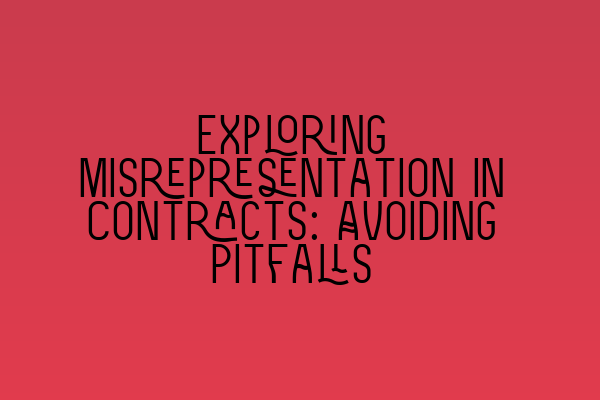Exploring Misrepresentation in Contracts: Avoiding Pitfalls
Welcome to our blog post on the topic of misrepresentation in contracts. In this article, we will dive deep into the world of contract law and explore the potential pitfalls that can arise from misrepresentation. It is crucial for both solicitors and clients to have a thorough understanding of misrepresentation to ensure fair and legally sound contracts. So, whether you are a solicitor, aspiring solicitor, or a client seeking legal advice, this article is for you.
What is Misrepresentation?
Misrepresentation refers to a false statement of fact made by one party to another during the negotiation stage of a contract. It can be either innocent, negligent, or fraudulent. Misrepresentation, if proven, can have significant consequences for the party who made the false statement, ranging from rescission of the contract to potential damages.
There are three main types of misrepresentation:
- Innocent Misrepresentation: Innocent misrepresentation occurs when a party genuinely believes that the statement made is true and has no reason to doubt its accuracy. Although innocent misrepresentation may not necessarily lead to a rescission of the contract, it can still impact the rights and obligations of the parties involved.
- Negligent Misrepresentation: Negligent misrepresentation occurs when a party makes a false statement without exercising reasonable care to ensure its accuracy. The party making the statement may not have intentionally deceived the other party, but their lack of due diligence can still result in legal consequences.
- Fraudulent Misrepresentation: Fraudulent misrepresentation is the most serious form of misrepresentation. It involves a deliberate and knowingly false statement made by one party with the intention to deceive the other party. Fraudulent misrepresentation can lead to severe penalties and damages for the party responsible.
It is essential for solicitors to identify the type of misrepresentation and advise their clients accordingly to protect their legal interests.
Elements of Misrepresentation
To establish misrepresentation in a contract, certain elements must be present:
- False Statement: The party claiming misrepresentation must prove that the other party made a false statement of fact. Mere opinions or statements of future intentions generally do not qualify as misrepresentation.
- Inducement: The false statement must have influenced the decision of the party relying on it to enter into the contract. If the statement did not play a significant role in the decision-making process, it may not be considered a misrepresentation.
- Reliance: The misled party must have reasonably relied upon the false statement. If they had the opportunity to discover the truth but failed to do so, the court may view their reliance as unreasonable.
- Damages: The party claiming misrepresentation must have suffered some form of damages or loss as a result of relying on the false statement. Damages can vary, ranging from financial losses to reputational damage.
These elements are vital to proving misrepresentation and building a strong case for your client. Properly evaluating and presenting evidence related to these elements can significantly impact the outcome of a misrepresentation claim.
Avoiding Misrepresentation: Best Practices
As a solicitor, your role is not only to rectify legal issues but also to prevent them from arising in the first place. Here are some best practices to help you avoid misrepresentation:
- Only provide accurate and truthful information to your clients. Avoid making statements that could be misconstrued or misinterpreted.
- Encourage full disclosure from your clients. Promote an open and transparent environment where clients feel comfortable sharing all relevant information.
- Exercise due diligence when reviewing and verifying facts. Conduct thorough research and investigation to ensure the accuracy of any statements made.
- Create detailed and precise contracts. Clearly define the rights and obligations of all parties involved to minimize the potential for misinterpretation or misunderstanding.
- Advise your clients to seek independent legal advice. Encourage your clients to consult with their own solicitors to ensure they fully understand the terms and implications of the contract.
By following these best practices, you can help your clients avoid the pitfalls of misrepresentation and maintain a strong professional reputation.
Conclusion
Misrepresentation in contracts can lead to significant legal consequences for both parties involved. As a solicitor, it is your responsibility to navigate this complex territory and provide sound legal advice to your clients. By understanding the different types of misrepresentation, the elements required to establish misrepresentation, and implementing best practices to avoid misrepresentation, you can protect your clients’ interests and ensure fair and legally binding contracts.
For more information on other topics related to contract law and legal practice, be sure to check out our related articles:
- Mentorship for Aspiring Solicitors: Nurturing Talent in the Legal Field
- Legal Challenges and Pitfalls: Navigating the Complexities of the Legal System
- Mastering the Solicitor’s Path: Prepare for the Journey Ahead
- The Benefits of Becoming a Solicitor: A Rewarding Career
- Law School in the UK: Your Guide to Starting Your Legal Journey
We hope you found this article valuable and informative. If you have any further questions or require legal assistance, please do not hesitate to contact us. Our team of expert solicitors is here to help.
